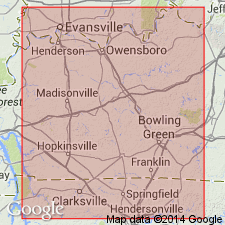
- Usage in publication:
-
- Tyrone beds
- Modifications:
-
- Named
- Dominant lithology:
-
- Limestone
- Shale
- AAPG geologic province:
-
- Cincinnati arch
Summary:
Named for Tyrone on the south bank of the Kentucky River, Anderson Co, KY. Tyrone beds are light or dove colored limestones breaking with conchoidal fracture, and exhibiting on fresh faces of the rock calcite facets that have suggested the name "Birdseye" for this formation. Beds of clay and clay shale occur throughout the formation. They vary in thickness from a few inches to a few feet. Fossils are not abundant. Unit is 90 ft thick.
Source: GNU records (USGS DDS-6; Reston GNULEX).
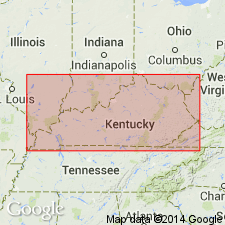
- Usage in publication:
-
- [Tyrone limestone]
- AAPG geologic province:
-
- Cincinnati arch
Summary:
Pg. 11-12. Tyrone [limestone] of High Bridge group. = "Birdseye limestone" of Linney (Miller, 1905). Dense, gray, dove, or cream-colored limestone, breaking with conchoidal fracture, and with small facets of coarsely crystalline calcite. On weathering the surface becomes white, in which the darker facets are conspicuous, giving rise to the name Birdseye. A bed of bentonite, a greenish clay a few inches to 5 feet thick, occurs 15 to 25 feet below top. This is a consistent horizon marker in deep drilling in the state. (Pencil Cave of southern and western Kentucky. In the eastern part of state the term is used for a shale break between the Glen Dean and lower Chester.) Is top formation of High Bridge (Highbridge) group. Overlies Oregon [limestone] of High Bridge group. Underlies Curdsville [limestone] of Lexington group; at several places, separated by a bentonitic shale [possibly Mud Cave], about 2 feet thick and more coarsely textured than lower bentonite. Age is Ordovician.
[On p. 12 (footnote) author states correlations have been changed in 1941 ed. of Schuchert and Dunbar's Historical Geology (John Wiley and Sons). Formations of the High Bridge placed in the Mohawkian; extend from upper Black River into lower Trenton. Camp Nelson along with the Oregon placed in upper Black River and correlated with the Lowville and Chaumont, respectively, of the New York section. The Tyrone was removed from the Lowville and placed at base of the Trenton (Rockland). In subsequent years, these correlations were adopted by most geologists; see also 1954 Correlations of the Ordovician Formations of North America, GSA Bull., v. 65.]
Source: Publication; US geologic names lexicon (USGS Bull. 1200, p. 2848); GNC index card files (USGS-Reston).
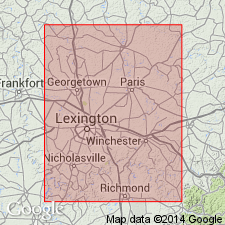
- Usage in publication:
-
- Tyrone limestone
- Modifications:
-
- Revised
- AAPG geologic province:
-
- Cincinnati arch
Summary:
Raised in rank to Tyrone limestone of Highbridge group. Approximately 90 feet in thickness. It is very pure limestone of birdseye or, in some places, lithographic type. Underlain by Oregon limestone (Highbridge group); overlain by Lexington group.
Source: GNU records (USGS DDS-6; Reston GNULEX).
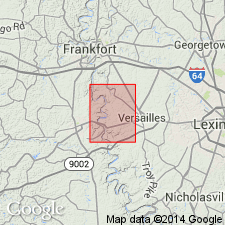
- Usage in publication:
-
- Tyrone Limestone*
- Modifications:
-
- Revised
- AAPG geologic province:
-
- Cincinnati arch
Summary:
Designated Tyrone Limestone of High Bridge Group.
Source: GNU records (USGS DDS-6; Reston GNULEX).
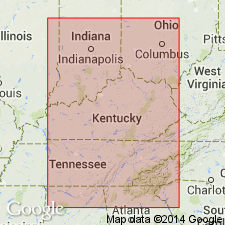
- Usage in publication:
-
- Tyrone Limestone*
- Modifications:
-
- Overview
- AAPG geologic province:
-
- Cincinnati arch
Summary:
The Tyrone Limestone of the High Bridge Group in KY consists of biopelsparites, biomicrites, and peritidal micrites that are similar to the underlying Oregon Formation, but contain less dolomite. Lithologies are arranged in shallowing upward cycles. Fossils contained in this unit are mostly mollusks, dominated by gastropods. Thickness is 55 to 155 feet. Underlies the Lexington Limestone. The Tyrone is of Middle Ordovician age.
Source: GNU records (USGS DDS-6; Reston GNULEX).
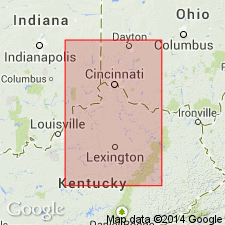
- Usage in publication:
-
- Tyrone Limestone*
- Modifications:
-
- Age modified
- AAPG geologic province:
-
- Cincinnati arch
Summary:
Tyrone Limestone of High Bridge Group in central Kentucky is source of a large variety of nautiloid cephalopods described in report. Conformably overlies Oregon Formation of High Bridge Group; disconformably underlies Lexington Limestone. Correlates with lower half of Carters Limestone in central Tennessee; upper half of Platteville Formation in Iowa, Wisconsin, and Minnesota (with Platteville Group in Illinois); Gull River Formation in southern Ontario; "Leray-Rockland beds" of Ottawa Formation in eastern Ontario; and Watertown, Selby, and Napanee Limestones in New York. Contains two distinct volcanic ash beds: Pencil Cave bentonite (drillers' term) and Mud Cave bentonite (drillers' term), both of which may be correlated with similar bentonite beds in upper Mississippi River Valley, central Tennessee, and southern Appalachians. Age is Middle Ordovician (Rocklandian to Kirkfieldian; a small portion of Tyrone extends into Kirkfieldian according to correlation chart of figure 2).
Source: GNU records (USGS DDS-6; Reston GNULEX).
For more information, please contact Nancy Stamm, Geologic Names Committee Secretary.
Asterisk (*) indicates published by U.S. Geological Survey authors.
"No current usage" (†) implies that a name has been abandoned or has fallen into disuse. Former usage and, if known, replacement name given in parentheses ( ).
Slash (/) indicates name conflicts with nomenclatural guidelines (CSN, 1933; ACSN, 1961, 1970; NACSN, 1983, 2005, 2021). May be explained within brackets ([ ]).

